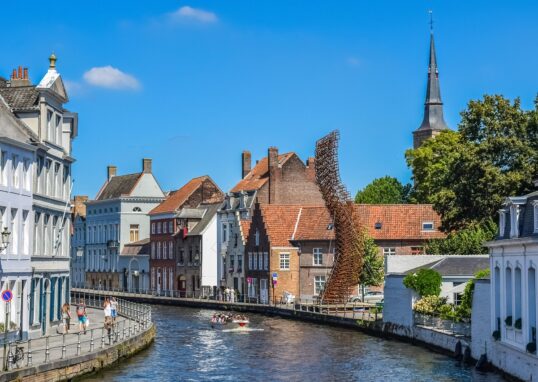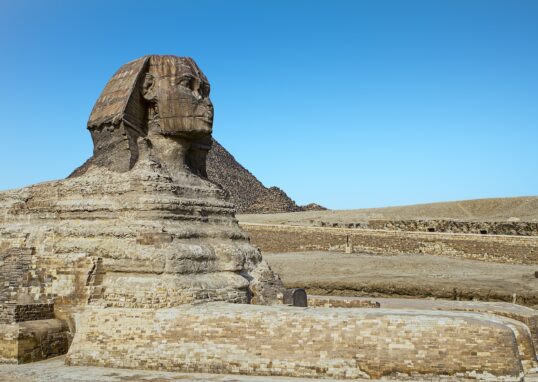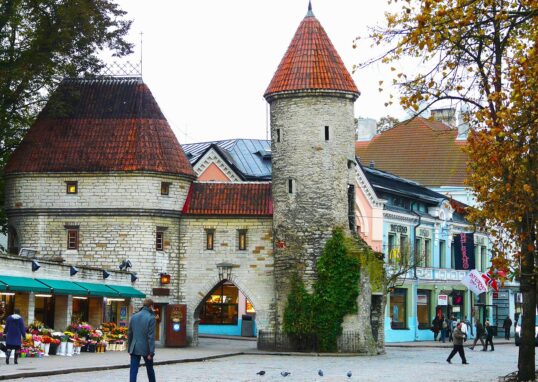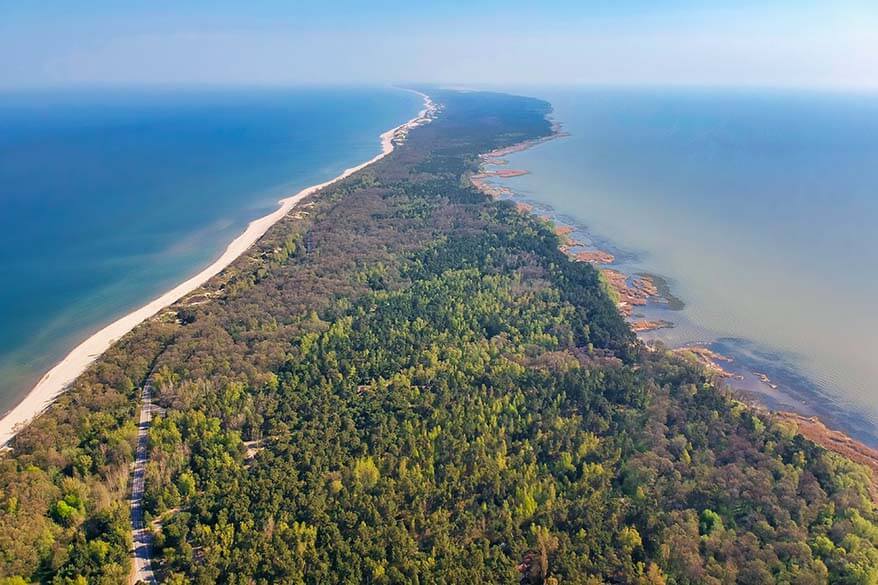
The Curonian Spit of Africa – A Hidden Coastal Wonder
On the sun-kissed shores of Africa lies an unimaginably beautiful and virtually unknown wonder-the Curonian Spit of Africa. This narrow strip of golden sand stretches from the Atlantic Ocean to a quiet inner lagoon. This is a place where the wind, sea, and time have created something magical. The African Curonian Spit is far from just a piece of land; it’s a living story of nature’s balance, human creativity, and peaceful coexistence of land and water. It follows the coastline in a golden ribbon of dunes, which rise like sleeping giants, and forests that tell ancient tales of wind and waves in a whisper. The air is fresh with salt and the soft breeze bringing the rhythm of the ocean. Many travelers who come here would say it is like stepping into some dream-a dream shaped by sand, sky, and sea. 
Formation and Landscape
The African Curonian Spit was born of wind and water. For many thousands of years, ocean currents had swept fine grains of sand from far shores. The winds piled these sands into rolling dunes to form one of the most striking natural barriers on the African continent. It is a chain of dunes that stretches about 98 kilometers, separating the great Atlantic Ocean on one side from a quiet lagoon on the other. At 60 meters high, the dunes offer wide panoramic views over endless water and desert-like beauty. The hues of the land change with the light: soft gold in the morning, warm amber at noon, deep bronze as the sun sets. Every moment seems to live. Sometimes, whipped by the wind, the dunes shift only a bit, their sand curled deftly into gentle waves; the result is a landscape that almost seems to breathe.
The Lagoon and Marine Life
On the inner side of the spit, lies the calm Curonian Lagoon, which stretches wide and bright under the African sun. Different species of fish and birds have their homes here, along with plants living in water. Local villagers often sail across the water with small wooden boats, fishing for tilapia, catfish, and even a few crabs. Early mornings, flamingos, pelicans, and herons fly gracefully across the lagoon. Their wings reflect in the still water to create a picture of absolute harmony. The soft rhythm of the lagoon brings peace to whoever comes to visit. Travelers come for kayaking, photography, or just for sitting in silence, heeding the music of nature.
Villages and Local People
One may also find tiny villages hidden in dunes and palm groves along the Curonian Spit of Africa. These are fishing and artisan communities where life is unhurried and traditions run deep. The people are warm, welcoming, and proud of their heritage by the sea. Families have lived here generation after generation, constructing homes of mud and thatch that blend into the landscape. They celebrate the sea through songs, dances, and art forms. Locals shape wonderful wooden boats, weave baskets from reeds, and colorfully paint shells in bright African colors. Their food is light, simple yet delicious. Fresh fish grilled with spices, rice prepared with coconut milk, and fruits such as mango and papaya perfume the air with sweet fragrances. A meal is a celebration of the sea and earth.
Cultural Heritage and Legends
The African Curonian Spit is famous not only for its beauty but also for the abundance of legends and folklore. The elders said the spit was made by a spirit of the sea to protect her people from storms; thus, with her hand, she took sand from far coasts and built this barrier against the ocean’s fury. Some stories talk of hidden spirits who live in the dunes, guarding the balance between sea and land. Locals say that, when night falls and the wind is very strong, it is a whisper from them to all, commanding respect for nature. Festivals are common here: once a year, villagers celebrate the “Festival of Sands,” a colorful event full of music, dancing, and lanterns. People come from faraway cities to join in and paint the dunes with joy and laughter.
Flora and Fauna
Curonian Spit of Africa is a highly biodiverse place. Despite the existence of sandy soil, it holds a lot of life within it. You can find various acacia trees, desert grass, and succulents with their thick leaves in order to store water. These plants survive the hot sun and salty air with ease. In forests close to the dunes, there live small mammals such as jackals, monkeys, and wild hares. The birdlife is especially rich: besides flamingos and pelicans, there are eagles, kingfishers, seagulls, and migratory birds that stop here while traveling between continents. The surrounding waters are full of marine life: dolphins playing near the coasts, at times even turtles coming ashore onto the soft sand to lay their eggs. Nature is untouched and pure here.
Tourism and Travel Experience
Travelers find the Curonian Spit of Africa the perfect blend of adventure and peace. The best time to be there is between October and March, as it is warm but not hot. Visitors can walk along the dunes, explore fishing villages, or simply take boat trips and lounge on the lagoon. Parts of this spit have been developed for ecotourism, with small lodges made from natural materials. These small lodges provide comfort to the guests without disturbing nature; they use solar energy, collect rainwater, and serve local food. Guided tours help visitors learn about the area’s history and ecology; there are walking trails, bird-watching towers, and viewpoints where sea and lagoon meet. Every time one turns a corner, a new scene of peace and beauty unfolds. At night, the sky becomes a canvas of stars. The Curonian Spit of Africa has almost no light pollution far from big cities, hence a paradise for stargazers and dreamers.
Environmental Protection
Even in this paradise on earth, the protection of nature plays a primary role. The dunes are very sensitive and may get destroyed by human intervention. For this reason, municipalities and ecological associations maintain the balance of nature together. They have established protected zones where animals can live without disturbance. Tourists are encouraged to walk on marked paths, not to litter, and avoid destruction of the environment. Education programs in nearby schools teach children about the importance of taking care of their land and sea. An agreement between people and nature makes the Curonian Spit of Africa the symbol of sustainable living, a kind of model showing how beauty and balance can exist together.
Surrounding Places
The Curonian Spit of Africa is flanked by some of the most interesting and varied landscapes on the continent. Every place around it has a story to tell-nature, people, and tradition. From the immediate surroundings of quiet lagoons and green hills, there are bustling towns with ancient forests that offer color and charm in plenty. For this reason, many travelers who come to the spit often explore these immediate regions to discover more of this hidden corner of Africa.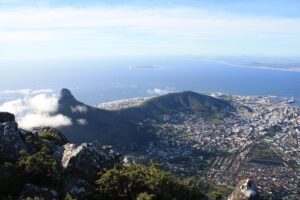
The Lagoon Town of N’Dura
The picturesque Lagoon Town of N’Dura, which lies just south of the Curonian Spit, is the most beautiful settlement along the calm lagoon waters. The town seems to float on water, with wooden houses on stilts above gentle waves, while the air is salty and fishy, and the paddles falling into the water sound rhythmically. Life in N’Dura is unhurried. The dawn finds fishermen wading into the lake, casting their glittering silver nets. In small markets, women sell fresh catch: tilapia, crabs, and shrimps in woven baskets. Children laugh and swim near the docks, and elders sit under the shade of palm trees and tell them tales about the sea. The marketplace of N’Dura is alive with color and sound: brilliant fabrics, hand-carved masks of wood, and jewelry fashioned from shells. The smell of grilled fish, spicy stews wafts through the air. At night, music rises from every corner: drums, flutes, voices singing in harmony. The people of N’Dura love to celebrate, and every evening feels like a festival of life. Visitors find small family-run guesthouses, and food is prepared with fresh ingredients: coconut rice, plantains, and seafood all cooked with love. At sunset, the sky takes on the pink and orange hues of the lagoon, making N’Dura a very special place to end one’s day.
The Coastal Savannah Plains
North of the Curonian Spit, the Coastal Savannah Plains stretch in a wide-open landscape with grass, acacia trees, and herds of animals as far as one’s eyes can see. The horizon is endless. Golden grasses dance with the wind, accompanied by the song of crickets. Pastoral communities live there; by taking care of nature, they have learned to live in harmony with it. People breed cattle, goats, and sheep, and they know each bush and each spring in the area. Their round hut cottages made of mud and straw rise above the ground with the smoke of the hearth curling lazily into the blue sky. At the break of dawn, the savannah glows under the first light. You can see herds of antelopes and zebras that graze peacefully. Sometimes, in the distance, elephants cross-their silhouettes grand and calm. Eagle, crane, and colorful bee-eaters are spotted here by birdwatchers flying across open fields. The people of the plains are very hospitable. Many tourists have been invited to drink tea with them, made from some wild herbs, and listened to traditional music played on home-made drums. Nights here are silent, full of stars. The vastness of the savannah makes a person feel so small and connected with earth at the same time.
The Serena Hills
Further inland from the Curonian Spit rises a rather beautiful chain of Serena Hills, emerald-green slopes covered with tropical forests and winding rivers. The hills are a paradise for all nature lovers; fresh air, cool streams, and breathtaking views of the coast beneath. The Serena Hills are teeming with life: among the rocks, one finds orchids, ferns, and wildflowers growing; monkeys swing from trees, while butterflies fill the air with color. Waterfalls tumble down the cliffs, their echo ringing through the valleys. Many travelers like this place to hike because they feel the peace of untouched nature. Small eco-lodges and retreats are tucked away among the hills, welcoming those seeking refuge from the din of modern life with herbal teas, organic food, and yoga or meditation in open-air pavilions. As evening falls, the forest sings: frogs, cicadas, and birds create a natural symphony that soothes the soul. Ancient stone pathways, built by early settlers, cross the hills. According to the locals, these had once formed part of a trade route that would connect villages inland with the coast. A walk along these trails is like going back in time, as one is surrounded by beauty and mystery.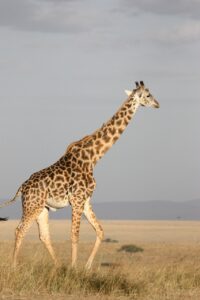
The Heritage City of Kambala
Only a few hours of driving from the Curonian Spit, the Heritage City of Kambala is located, one of the most charming and historic cities in the region, at the crossroads of old traditions and new life. It has cobblestone-paved streets and narrow alleys lined with colorful buildings. Kambala boasts colonial architecture, vibrant marketplaces, and an art scene. Centuries ago, the city was a trading port where European, Arabian, and African merchants would meet and exchange goods and stories. The past lives on today in its museums, old churches, and seaside forts.
The Old Town Square is the heart of Kambala, where musicians play local tunes, artists display their paintings, and families gather under the shade of old trees. In the cafes, one finds strong African coffee and sweet pastries with dates and honey. The smell of roasted cocoa and cinnamon fills the air. The sea-related history of this city is often narrated in the Maritime Museum, while Fort Nyasha proudly rises on a hill outside, overlooking the sea, centuries after its construction. From its towers, one can see the endless blue horizon and imagine the ships which once navigated these waters. It is also famous for its annual cultural festival, where people from all over the country come to join in the music, dance, and art. The celebrations go on for days and nights with parades, performances, and fireworks that light up the sky.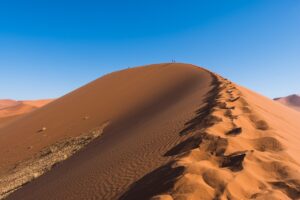
The Golden Coast National Park
Beyond Kambala, further ahead, lies the Golden Coast National Park, extending from inland forests right to the ocean coast. A vast national park and a treasure trove of biodiversity, home to some of the most handsome creatures of Africa’s inventory. It allows the visitor to view elephants, lions, leopards, and giraffes in their natural environment, roaming freely. Wetlands are full of flamingos and storks, while the dense forests are packed with chimpanzees and parrots. This park is an ideal place for people who love safaris and photography. Its name is derived from the golden color that engulfs the landscape at sundown. The light changes the color of the grasses and trees into amber and copper shades. This, therefore, creates a moment of pure magic-a thing that only gets etched in your memory forever. They organize jeep safaris, walking tours, and river cruises for tourists. They explain how the park protects the wildlife and helps the local communities with eco-tourism. The park also has some lodges made of sustainable material so that it provides comfort but with very slight harm to the environment.
The Whispering Dunes
Those who love adventure will find mountain trails, campsites, and secret waterfalls to discover. The Golden Coast National Park reminds us once again of Africa’s wild beauty and the need for its preservation for generations to come. The Whispering Dunes Not far from the southern edge of the Curonian Spit, there is something called The Whispering Dunes. These dunes are smaller but more mysterious than the main spit. The wind moves through them in such a fashion as to produce a soft humming sound-like whispers from another world. The dunes are considered sacred by local people. They claim that the sounds are the voices of ancient spirits guarding the coast. Travelers often sit quietly, listening to the wind, and find great peace. The dunes are encircled by salt flats that shimmer in patterns created by sunlight on the ground. This is a magical place at night, when the stars shine and the moon reflects on the white sand. Some say that if you make a wish while the dunes whisper, it will come true.
Conclusion
The Curonian Spit of Africa may exist in imagination, but it carries a very real message-a message about harmony between nature and people. It can exemplify how beauty comes out through the dancing wind and water, livelihoods gentle on the land, and travelers respectful to the world they explore. This golden land between sea and lagoon is a symbol of peace, balance, and hope. Whether you imagine walking barefoot on its sands or watching the sunset over its dunes, the Curonian Spit of Africa invites you to dream of a world where nature and humanity exist in perfect rhythm.


